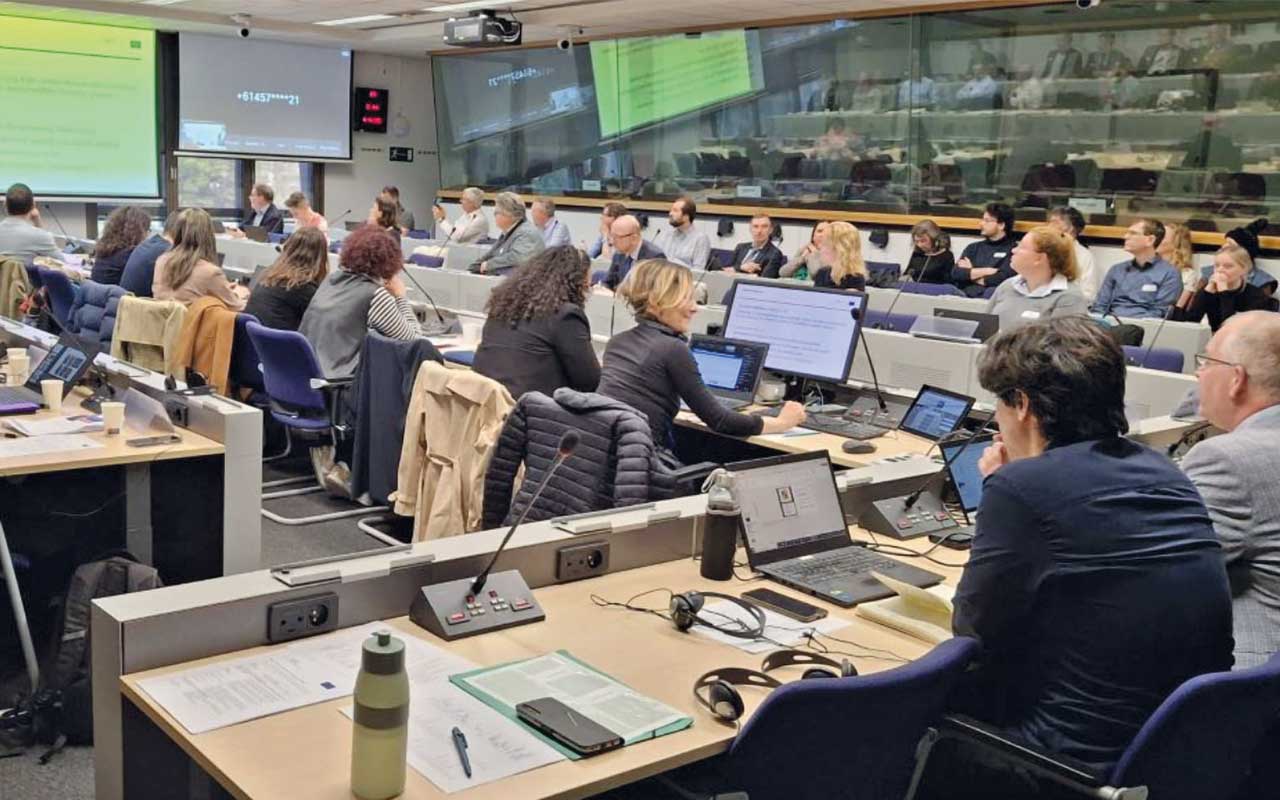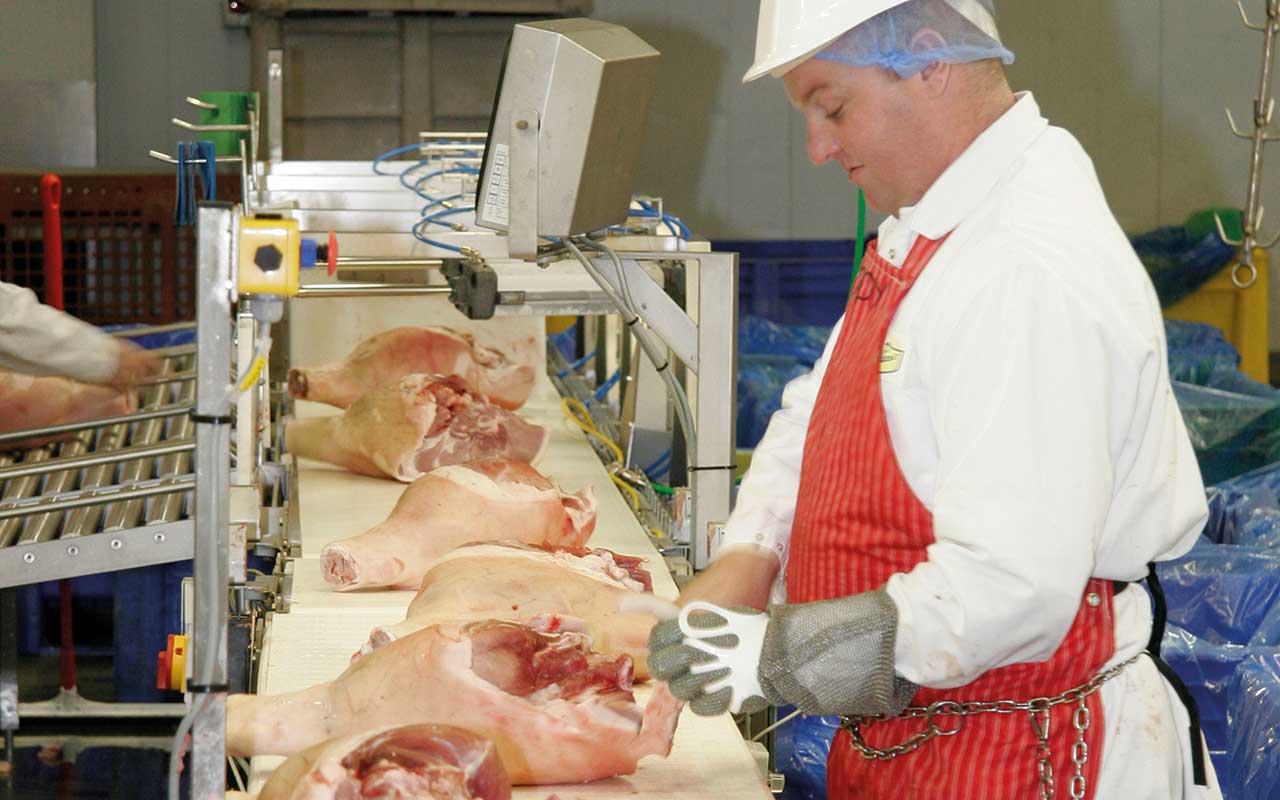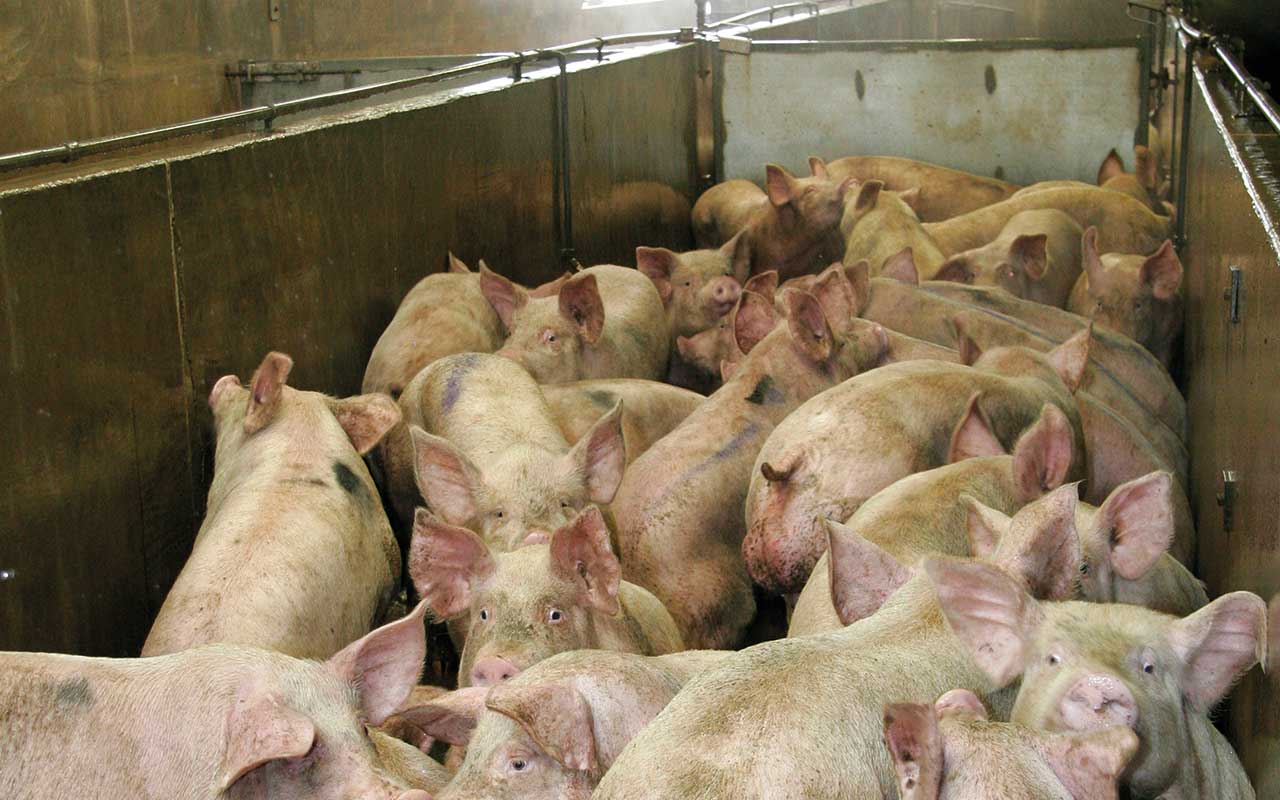Is there a better way to slaughter pigs? This is a big question that is increasingly being asked, not just by animal welfare groups, but by industry, policymakers and scientists.
The answer, as ever, is not straightforward, as a meeting held in April to discuss the EU PigStun project demonstrated.
It discussed ongoing research on potential alternatives to the use of carbon dioxide (CO2) and, although there are plenty of encouraging signs, an obvious alternative that can improve pig welfare while also being practical and cost-effective to implement is yet to materialise, according to NPA senior policy adviser Katie Jarvis.
CO2 stunning
In the UK and Europe, all pigs are required to be stunned before slaughter. In the UK, about 80% of pigs are stunned and killed using CO2, according to the Humane Slaughter Association (HSA), with large abattoirs generally using this method. Electrical stunning is also permitted and is often used by smaller plants.
The Welfare of Animals at the Time of Killing (England) Regulations allow CO2 to be used to also kill the animals after stunning, requiring those pigs to be killed by exposure to high concentrations of CO2.
Under this method, pigs, often in groups, are lowered into a chamber containing a minimum concentration of 80% CO2 mixed in the air. The pigs lose consciousness and, in the UK, must remain in the gas mixture until dead.
In practice, most operators use concentrations of over 90%, as this results in a quicker loss of consciousness and is a requirement of many retailer/third-party assurance standards.
EU law differs to the UK when it comes to CO2 use – it allows pigs to be rendered unconscious by CO2 and then killed using another method, typically by cutting the neck.

Aversive effects
While everything possible is done to minimise any negative welfare effects, CO2 has been shown to be ‘strongly aversive’ to pigs because it causes breathlessness or pain in high concentrations and anxiety even at lower concentrations, HSA said.
As a result, it recommends that CO2 is replaced with a more humane method ‘as soon as possible’ – and it is far from alone in this view.
The RSPCA and Compassion in World Farming (CIWF) recently published an open letter to Defra secretary Steve Reed, copying in the big retailers, calling on the UK government to ‘show leadership on delivering an end to using high concentrations of CO2 for killing pigs’. They noted that more than two decades ago, the Farm Animal Welfare Committee recommended phasing out CO2 but said there has been little progress since.
RSPCA and CIWF said the move was ‘long overdue’ as the use of CO2 to stun and kill millions of pigs each year was ‘widely recognised as causing pain and distress before the animals lose consciousness’.
The RSPCA said it has identified various pathways to improve pig welfare at slaughter:
- Government to change the law to allow gas to be used to stun, rather than kill pigs, as permitted in the EU, making the use of alternative gases in the UK much more feasible.
- Retailers and slaughterhouses to start trials to develop a commercially viable alternative in the UK to facilitate a humane transition.
- Government to support slaughterhouses by funding the retrofitting of existing CO2 sites to allow for the use of less-aversive inert gases, such as argon.
“The UK has long been a leader in animal welfare standards. Now is the moment to demonstrate that leadership once again,” the letter from RSPCA chief executive Shan Nicholas and CIWF chief executive Philip Lymbery said.
Announcing its new standards for pigs, which came into force in March, RSPCA Assured said, as part of its standards in future, it ‘wants to see a rapid phase-out of the legal use of CO2 gas killing systems in their current form, and humane alternatives developed’.
Best available practice
In a briefing on CO2 stunning published in June 2024, the NPA points out that, while CO2 is aversive at high concentrations, it also has a direct anaesthetic and pain-relieving effect, which results in loss of consciousness more quickly than with some other low-oxygen gas mixtures, such as argon and nitrogen
CO2 controlled-atmosphere systems also reduce the risk of potential human error, while modern controlled-atmosphere systems enable improved handling of pigs, through the use of automatic gates, reducing stress.
The briefing said controlled-atmosphere killing of pigs ‘currently represents a best available practice when operated correctly and monitored carefully’.
It added that while an alternative non-aversive gas mixture would be preferable from an animal welfare standpoint, no such alternatives are currently commercially available or approved for use by government.
The NPA is currently updating its CO2 briefing, in light of recent research.
However, Defra is keen to address these welfare concerns, and has asked the Animal Welfare Committee (AWC) to provide it with a ‘comprehensive animal welfare assessment’ of the evidence on high-concentration CO2 stunning of pigs, and alternative pig stunning methods.
To support this, a call for information, meetings with industry stakeholders, NGOs and academic experts, and visits to pig slaughterhouses have taken place in recent months. The committee will report back this summer.

PigStun project
Under the European Commission-funded PigStun project, which started in 2022, researchers have worked with slaughterhouses in Germany, Denmark, Spain and the Netherlands to test alternative stunning methods for pigs to replace conventional CO2 stunning. The outcomes of this research were discussed during a meeting in Brussels in April, which was broadcast online.
It discussed research on:
- An optimised controlled-atmosphere stunning (CAS) process, in which pre-stunning handling and the gas mixture are adjusted in a conventional CO2 system.
- Argon retrofit system, in which the inert gas replaces CO2.
- Helium stunning system, in which CO2 is substituted with helium.
- Improved electric stunning process, in which pigs are stunned using an electric stunning system with an optimised pre-stun handling facility.
The research covered various parameters, including pig welfare, but also factors like cost, practicality, the effect on meat quality and employee safety.
Ms Jarvis followed proceedings carefully and summed up the pros and cons of each system.
1. Optimised CAS process
The optimised CAS process aimed to achieve better control over CO2 (and O2) concentrations through the integration of additional sensors and continuous checking to ensure that the desired levels are maintained. The system was tested with CO2, but can be used with other gases.
It also aimed to improve pre-stunning handling of pre-grouped animals into the CAS system to minimise the stress levels of the pigs.
Ms Jarvis summarised the findings:
- Although still based on high CO2 levels, it was considered an improvement in welfare terms to more variable conventional systems.
- The changes enhanced the pigs’ welfare beyond conventional CO2 by supporting calm, low-stress movement to the stunner.
- It reduced the need for manual pig handling, with less contact with pigs required.
- It was supportive of good meat quality and reducing the occurrence of PSE (pale, soft, exudative) meat.
- A relatively small initial investment was required to retrofit existing equipment. A tunnel system, which was also considered, would require higher investment, but would probably provide longer-term efficiency and reliability.
- The improved gas microclimate reduced wastage and, therefore, CO2 emissions.
2. Argon retrofit
Nitrogen and argon have been tested in different concentrations in Germany. The alternative gas combinations can be fitted into existing CO2 systems.
In summary:
- Aversion can be strongly reduced, and pre-stunning stress was also lowered.
- High-concentration argon was the most promising, but it requires 40% longer exposure compared with CO2.
- Argon can be produced in practically unlimited quantities.
- Meat quality differed across the trials, and there were relatively high numbers of blood spots.
- Conversion could be implemented relatively quickly.
- It would lower throughput, and the estimated cost per pig is two to three times higher than CO2.
- There is a risk of inhalation by humans of toxic levels of argon.
3. Helium stunning
The helium system was used in a tower, instead of a pit, as helium can’t be kept in a pit. It was delivered in a double-walled container with a recovery system for helium, which recovers about 90% of the gas. The pigs can enter it in the same way as for CO2.
The system was tested on 50 pigs per hour, but this could be significantly increased with, for example, an improved loading system, and a second tower.
In summary:
- It delivered a significant improvement in welfare, with animals showing no reaction while losing consciousness.
- The stunning time was 200 seconds, considerably longer than with CO2. To reach capacity would require multiple stunners.
- It was a completely automated process, from moving the pigs to the stunner to ejecting from the stunner, reducing workload.
- The helium was significantly more expensive than CO2, although helium recovery can help.
- Helium is a limited resource and can be difficult to obtain.
- There were more blood spots on the meat than with CO2, comparable with argon.
- Helium escapes upwards, so the safety of employees was not considered a risk through helium escape.
4. Improved electrical system
This approach aimed to improve the process of electrical stunning with special emphasis on throughput rate, pre-stunning handling, design of raceways and entrance of pigs into the stunner.
It included installing four electrical stunners, instead of one, to reduce the maximum number of animals per stunner per hour, guiding pigs in small groups from the lairage to the raceway and allowing them to choose which raceway they walked on to enter the stunner. The aim was to improve the entire process from an animal behaviour perspective, from lairage to stunner.
It was studied in a commercial setting, already functioning at a high throughput of 650 pigs an hour.
In summary:
- 20% of pigs needed to be prodded to move them into the stunner, which the audience felt was still quite high and probably more stressful for the pig than in a more conventional electrical system.
- Exposure time and accuracy was improved due to longer exposure in the stunner.
- There was a significantly lower throughput rate and increased costs per pig compared with conventional electrical stunning.
- The lower throughput rate reduced the need for driving aids, however.
- The pH decline in meat was improved compared to conventional electrical stunning. But, again, there were more blood spots compared with CO2 stunning.
- Using four stunners meant more time needed for cleaning and more electricity used.
- More staff are needed to work along the race and at bleeding.
The project will, at some point, deliver recommendations based on these findings that could include a move away from CO2.

No ‘best option’
Ms Jarvis said: “The EU PigStun project has been an extremely insightful piece of research that highlights both the opportunities for higher-welfare slaughter alternatives to CO2, but also the barriers to developing them commercially.
“It has provided a wealth of information but, unfortunately, there is still no conclusive ‘best’ option due to various issues with the different methods studied when it comes to throughput capacity, meat quality and cost.
“The NPA, of course, acknowledges concerns expressed by citizen groups and welfare campaigners that slaughter could and should be more humane.
“We are part of a UK pig sector group that is committed to exploring alternatives and finding a solution that can deliver on animal welfare for pigs.
“But any new approach must be commercially viable to ensure uptake, maintain meat quality and avoid any unintended consequences for welfare. For example, throughput capacity must be sufficient to ensure that pigs are not held on farm or in lairage for longer than necessary,” Ms Jarvis said
“The UK pig industry must now work together to decide how we go forward.”
British Meat Processors Association chief executive Nick Allen said: “The use of group CO2 stunning for pigs has, for a number of years, been widely recognised as the most humane method available and is best practice in major abattoirs across the world.
“We continue to take an active interest in academic research on alternative stunning methods from across the world. We have also supported local research work and are open to further innovation in this area.”
Highest standards
Defra said it is actively looking at alternative approaches and is ‘considering the options available’. This includes ‘reflecting on’ the results of the EU PigStun project.
A Defra spokesperson said: “This government wants to see the highest possible standards of animal welfare at slaughter, which is why we have commissioned the independent AWC to carefully assess the evidence around high-concentration CO2 stunning.
“We were elected on a mandate to introduce the most ambitious plans to improve animal welfare in a generation – that is exactly what we will do”.




